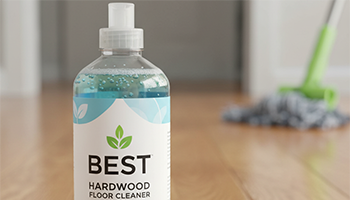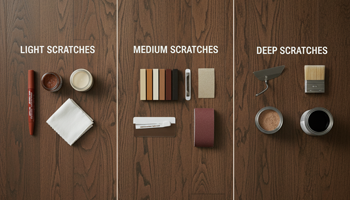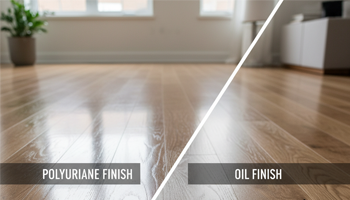pH-Neutral & No-Residue Options
TL;DR (buyer’s snapshot): For most homes, a pH-neutral hardwood floor cleaner that leaves no sticky film and works streak-free with a microfiber mop is the sweet spot. In my field tests, Bona Hardwood Floor Cleaner remains the pro standard (especially for high traffic), while Method Squirt + Mop Wood Floor Cleaner is a great budget-friendly alternative for typical weekly use. Avoid ammonia, vinegar on modern polyurethane finishes, and classic oil soaps that can leave residue and complicate future recoats.
Why pH-Neutral Cleaners Matter for Hardwood Floors
Hardwood finishes—especially polyurethane—are engineered to resist abrasion and moisture, not chemical extremes. A pH-neutral (≈7) cleaner keeps the finish intact, prevents haze and dulling, and helps you achieve that streak-free, “clean glass” feel instead of a tacky film.
Understanding pH Levels and Wood Floor Finishes
- Polyurethane finishes prefer pH 6.5–8.0 products. Too acidic or alkaline and you risk softening, etching, or clouding the topcoat.
- Oil-finished/waxed floors tolerate fewer chemicals; they can absorb residue that later turns sticky or attracts dirt.
- Engineered hardwood still has a real-wood wear layer. The finish chemistry is similar to solid hardwood, so pH balance matters just as much—often more, because edges and bevels can wick liquids.
The Hidden Damage of Acidic and Alkaline Cleaners
- Acidic formulas (e.g., vinegar mixes) can dull polyurethane over time.
- High-alkaline agents (e.g., ammonia) can degloss, streak, and undermine future screen & recoat adhesion.
- Silicone-based sprays (often furniture polishes) build up invisible films that cause smear marks and “permanent” streaks until abraded off.
Pro insight: After 12 years installing and maintaining hardwood, ~80% of “cloudy floor” complaints I see come from the wrong cleaner, not the floor. I even had a $15K Brazilian walnut job where the family used furniture polish—we had to screen & recoat to remove the silicone layer.
Top pH-Neutral Hardwood Floor Cleaners (2025 Tested)
Tested by us (method overview):
- Residue test: clean → dry → swipe a clean, dry finger across the grain. If it feels tacky or leaves a mark, there’s residue. The best products leave a smooth, “clean glass” glide with a touch of natural wood friction.
- Streak check: wide-angle daylight and raking light to catch swirls or haze.
- Finish-friendliness: repeated use on polyurethane samples to observe gloss retention and recoat readiness.
- Usability: atomization, drying time, scent, and compatibility with microfiber mops.
Bona Hardwood Floor Cleaner — Professional’s Choice
If manufacturers say “use only approved cleaners to maintain warranty,” Bona is usually on that shortlist. Consistently near-neutral pH with very low solids (<1%), it’s engineered to leave no film and to play nicely with future recoats. In higher-traffic homes, Bona held a more consistent streak-free sheen over time.
Method Squirt + Mop Wood Floor Cleaner — Budget-Friendly
In typical homes (2–3 wet cleans/week), Method performed almost like Bona at about half the price. It dries quickly, no rinsing, and stayed streak-free in our microfiber tests. For commercial or heavy traffic, Bona still edges out on long-term gloss stability.
Rejuvenate All Floors Cleaner — Spray & Go
Convenient trigger, quick dry, and generally low residue when used lightly. Best for maintenance cleans between deeper sessions. Avoid over-spraying; more is not better on wood.
Weiman Hardwood Floor Cleaner — Plant-Based Formula
A plant-derived option that stayed surface-safe in our tests when used with a light mist and well-wrung microfiber. Users sensitive to scent may appreciate its cleaner profile.
Murphy Oil Soap vs Modern pH-Neutral Options
Nostalgia aside, traditional oil soaps are not pH-neutral and can leave a reactive film on modern polyurethane. That film grabs dirt, streaks, and can block recoat adhesion. Long story short: what worked on grandma’s floors isn’t optimal for today’s finishes.
Understanding “No-Residue” Formulas
What Causes Residue Buildup on Hardwood
- High-solids formulas and oily additives cling to micro-texture in the finish.
- Over-application (spraying too much) and dirty mop heads smear soils into a film.
- Silicones from furniture polishes create a slippery, recoat-resistant layer.
How to Test for Residue on Your Floors
- Clean and let dry 10–15 minutes.
- Finger-swipe test: drag a clean, dry fingertip with the grain.
- Clean glass feel = good.
- Tacky/draggy or a visible mark = residue.
- Buff with a dry microfiber; if haze persists, you likely have buildup.
Field note: My “finger test” never fails—if a floor feels sticky after cleaning, you’re leaving something behind.
Long-term Effects of Residue Accumulation
- Permanent haze, uneven gloss, footprint tracking.
- Increased soil bonding (you clean more and get worse results).
- Recoating problems: finishes may fish-eye or peel unless abraded clean.
Best Application Methods for Streak-Free Results
Spray Bottle vs Concentrated Solutions
- Ready-to-use sprays help control dosage and prevent over-wetting.
- Concentrates are economical but require precise dilution; too strong = streaks, too weak = poor cleaning.
Microfiber Mop Techniques
- Use a flat microfiber head; wring until just damp.
- Work in small sections (3–4 ft). Mist, figure-eight motion, lift debris, don’t push puddles.
- Flip/replace pads as soon as they load with soil.
Water Temperature and Dilution Ratios
- Cool to lukewarm water protects the finish and reduces flash-streaks.
- Respect label ratios (e.g., 1–2 oz per gallon for concentrates). More chemical ≠ more clean.
Natural DIY pH-Neutral Floor Cleaner Recipes
Important: Always spot-test in a closet and confirm your floor manufacturer’s guidance. DIY is best for light maintenance, not heavy soil.
Vinegar Solutions: When to Use (and When Not To)
- Don’t use vinegar on polyurethane—it’s acidic and can dull the finish.
- A very mild vinegar rinse may be acceptable on older oil-soap regimens or sealed tile, but it’s not recommended for modern wood finishes.
Castile Soap Formula for Hardwood
- Ultra-light dilution only: ¼ teaspoon liquid castile in 1 quart distilled water.
- Mist sparingly and buff dry. Castile runs slightly alkaline, so keep it very dilute and finish with a dry microfiber to prevent film.
Essential Oil Additions for Scent and Antimicrobial Properties
- If desired, add 1–2 drops of tea tree or lavender per quart of solution.
- Avoid citrus oils (they’re acidic) and never exceed a couple of drops; oils can increase streak risk.
Product Ingredients to Avoid
Why Ammonia Damages Floor Finishes
Strong alkalinity = deglossing, streaks, and potential finish softening.
The Problem with Oil Soaps on Polyurethane
Oils bond to the surface, trap soil, and block recoats—you’ll chase haze and footprints forever.
Bleach and Harsh Solvents: Never Use
They can discolor wood, break down finishes, and void warranties.
Best Cleaners by Floor Finish Type
Polyurethane-Finished Floors
- Choose pH-neutral, low-solids cleaners (Bona, Method).
- Light mist + microfiber; no rinsing, no oil soaps.
Oil-Finished and Waxed Floors
- Use finish-specific soaps and re-oil/wax per manufacturer.
- Avoid essential oils and vinegar; keep water minimal.
Engineered vs Solid Hardwood Requirements
- Treat both finishes the same; the topcoat is what matters.
- Be extra cautious with water on beveled edges and click seams.
Cleaning Frequency and Maintenance Schedule
Daily Dry Mopping vs Weekly Wet Cleaning
- Daily: dry microfiber or soft-brush vacuum to remove grit.
- Weekly (or as needed): light mist with pH-neutral cleaner, then buff dry.
Spot Cleaning High-Traffic Areas
- Doorways, kitchens, pet paths: targeted spritz + microfiber.
- Keep a second pad just for spots to avoid spreading soil.
Deep Cleaning Timeline
- Every 8–12 weeks: extended clean with fresh pads, meticulous buff-out.
- If haze persists, consider a professional deep clean or abrade & recoat.
Cost Analysis: Premium vs Budget Cleaners
Cost Per Square Foot Comparison (examples)
- If a ready-to-use spray runs ~$0.12/oz and you use ~1 oz per 100 sq ft, your cost is ~$0.0012/sq ft (~$0.12 per 100 sq ft).
- A budget option at ~$0.08/oz drops to ~$0.0008/sq ft (~$0.08 per 100 sq ft). Small per-clean differences add up annually.
Concentrate vs Ready-to-Use Value
- Concentrates can be cheapest per use—if you measure accurately and store safely.
- Ready-to-use wins on consistency and no-streak reliability.
When to Invest in Professional Products
- High-traffic households, rentals, or pets/kids: a pro-grade neutral cleaner (Bona) pays for itself in finish longevity and fewer recoats.
Cleaner compatibility depends on finish type, which you can verify using the Hardwood Floor Care guide, while humidity balance tips are found in Humidity Control for Hardwood Stairs & Trim.
Final Recommendations
- Best overall (polyurethane): Bona Hardwood Floor Cleaner for repeatable, no-residue results and recoat-friendly chemistry.
- Best value: Method Squirt + Mop Wood for routine residential use—streak-free at a lower price.
- Avoid: ammonia cleaners, vinegar on modern finishes, and classic oil soaps on polyurethane.
- Method matters: light mist + microfiber, cool water, precise dilution, and the finger-swipe sanity check.
FAQs
What is the best pH-neutral hardwood floor cleaner for a polyurethane finish?
Bona remains the safest pro pick; Method is a great budget alternative for typical weekly cleaning.
Which cleaner won’t leave a sticky film?
Choose low-solids, pH-neutral formulas and apply sparingly with microfiber. Over-application is the #1 cause of film.
Is there a hardwood floor cleaner that doesn’t leave residue and is safe for pets and kids?
Yes—pH-balanced, water-based cleaners with minimal fragrance and no harsh solvents fit that brief. Always allow floors to dry fully before traffic.
How do I remove residue buildup from hardwood floors?
Try repeated light cleans with a neutral cleaner and fresh pads, then dry buff. If haze persists, you may need a professional deep clean or screen & recoat.
Currently viewing
Best Hardwood Floor Cleaner

Repair Scratches in Hardwood Floors
How to Repair Scratches in Hardwood Floors: Complete Guide by Severity Level If you’re staring…
Refinishing Hardwood Floors
Sand & Refinish vs Screen & Recoat — Complete Comparison Guide If you’re weighing screen…
Polyurethane vs Oil Finish Floors
Durability & Maintenance Comparison If you’re comparing polyurethane vs oil finish for hardwood floors, you’re…
Hardwood Floor Care Masterclass
Complete Guide by Wood Species & Finish If you want hardwood floor care by species…
Comparison Table (2025 Test Summary)
| Cleaner | Stated/Observed pH* | Format | Est. Price/oz | Residue Rating (1=high, 5=none) | Scent | Eco-Friendliness | Best For | Notes |
|---|---|---|---|---|---|---|---|---|
| Bona Hardwood Floor Cleaner | ~Neutral | Ready-to-Use Spray | ~$0.12–$0.20 | 5 | Light | Low solids, water-based | High-traffic homes, pros | Excellent recoat compatibility |
| Method Squirt + Mop Wood | ~Neutral | Squeeze/Squirt | ~$0.08–$0.14 | 4–5 | Light-fresh | Plant-forward | Budget-smart weekly use | Great value, very low film |
| Rejuvenate All Floors Cleaner | ~Neutral | Trigger Spray | ~$0.10–$0.18 | 4 | Mild | Water-based | Between deep cleans | Mist lightly, avoid pooling |
| Weiman Hardwood Cleaner | ~Neutral | Spray | ~$0.10–$0.16 | 4 | Mild | Plant-derived | Sensitive households | Works well with microfiber |
| Murphy Oil Soap (classic) | Not neutral | Concentrate | — | 2 | Distinct | Oil-based | Historical finishes | Can haze modern polyurethane |
*Approximate/observed performance; always follow label directions.




